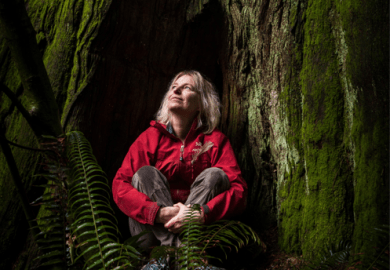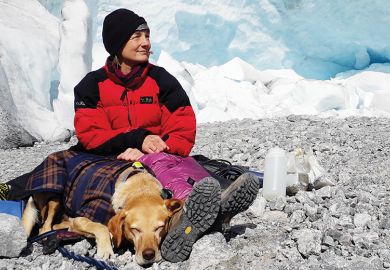The major features of the fossil record were sketched out more than 150 years ago and even in those early days the apparently abrupt appearance of organised marine invertebrates at the base of the Cambrian system had been recognised as a crucial, if puzzling, phenomenon.
At that time, our knowledge was based solely on hard-shelled animals such as trilobites and brachiopods, and apart from trace fossils, there was no real record of any soft-bodied Cambrian fauna. But in 1909 came the discovery of the Burgess Shale, a Middle Cambrian deposit in British Columbia, Canada, with a vast variety of soft-bodied or unmineralised arthropods, lobopods, annelids and many other forms of bizarre design and no clear zoological affinity.
These fossils, and their geological setting, were the subject of intensive research, both by their discoverer, Charles Walcott, and by Harry Whittington and his team in the last 35 years of the 20th century. At first, the Burgess Shale-type preservation seemed to be a unique phenomenon, a never-to-be-repeated insight into Middle Cambrian diversity.
Yet more was to come. First there were discoveries of three-dimensional phosphatised arthropods in the Upper Cambrian of Sweden. Then Lower Cambrian soft-bodied fauna were found in north Greenland, and the astonishing Chengjiang biota from southern China, the subject of this book, were discovered. Found in 1984 by Hou Xian-guang, its importance was recognised immediately. Intensive collection soon revealed that this fauna was probably of even greater diversity than that of the Burgess Shale. But it was even older and, as Richard Fortey puts it in his preface, "taking us still closer to what has been described as the 'big bang' in the dawn of complex animal life".
Hou brought his material to Stockholm for detailed investigation with Jan Bergström. Further fossil-bearing localities were found in the Chengjiang region and other scientists joined the team. Reports came through in various scientific journals of strange creatures such as Fuxianhuia, with its elongated segmented body, narrow abdomen and curious combination of primitive and advanced characters. Now the results of this ongoing research are accessible to all geologists and biologists in this enchanting volume.
This is a fine book, written by a respected team of Chinese, Swedish and British scientists. It is beautifully produced and all the maps, charts and photographs are in colour, the last faithfully reproducing the yellow, brown, red and pink of the flattened fossils and the contrasting paler sediment. Following Fortey's foreword, and a preface by the authors, the first part describes the geological and evolutionary history of the biota.
Six chapters deal with geological time and the early evolution of life on Earth, the evolutionary significance of the Chengjiang biota, how it was found (with an engaging illustration of the page of Hou's notebook recording the discovery), the geological setting of the fauna, and the nature and processes of preservation and palaeoecology. The ecosystem was complex, with swimming, floating and bottom-dwelling organisms, but dominated by arthropods. Various feeding types are represented - predators, scavengers, filterers and probably deposit feeders.
Part one is concise and eminently readable. Sensibly, the issue of whether the Cambrian "explosion of life" is real or an artefact of the fossil record is discussed but left open. The only matter that is rather avoided here is the precise age of the fauna. The base of the Cambrian is now taken at about 543 million years, and the top at about 490 million. It is now known that the first appearance of trilobites was preceded by quite a long period of time with small shelly fossils (the Meishucunian stage in China).
The first trilobites appear at the base of the next stage (the Qiongzhusian in China), and the Chengjiang fauna is found just a little way above the base. It is probably about 525 million years old, though doubtless this date will be refined in future. Whatever the exact age, it provides a very early window into the phenomenal diversity of life in the early Cambrian, which is explained and illustrated in part two.
This part is a superbly illustrated inventory of the various organisms present in the Chengjiang fauna. Some belong to genera already known from the Burgess Shale, but others are unique to this fauna. There are algae and representatives of at least 14 phyla, sponges, cnidarians, ctenophores, nematomorphs, priapulids, chateognaths, hyolithids, possible annelids, lobopods, anomalocarids (here provisionally regarded as a separate phylum) and arthropods of many different kinds, including hard-shelled trilobites.
Other phyla include phoronids, brachiopods, chordates and vetulicolians (whatever they may be). In addition, there are several strange animals that cannot readily be assigned to any one phylum.
Altogether 129 species have been recorded from the Chengjiang fauna, of which 105 are described, one to a page, with comments on probable lifestyle and key references. The facing page has photographs of the organism and for many species of arthropods and lobopods an impression of the animal as a living creature. The appendages of these same animals are of the greatest interest for phylogeny and they are preserved in many species. The Chengjiang fauna has also yielded the earliest vertebrate, Myllokunmingia , a fish-like form, though as yet known from only a few specimens. A reference list and index complete the volume.
Research continues, but this book presents an invaluable summary of our current knowledge. At £60 it may seem expensive, but the quality is such that it is worth every penny.
Euan Clarkson is emeritus professor of palaeontology, Edinburgh University.
The Cambrian Fossils of Chengjiang, China: The Flowering of Early Animal Life
Author - Hou Xian-guang, Richard J. Aldridge, Jan Bergström, David J. Siveter, Derek J. Siveter and Feng Xiang-hong
Publisher - Blackwell
Pages - 233
Price - £60.00
ISBN - 1 4051 0673 5
Register to continue
Why register?
- Registration is free and only takes a moment
- Once registered, you can read 3 articles a month
- Sign up for our newsletter
Subscribe
Or subscribe for unlimited access to:
- Unlimited access to news, views, insights & reviews
- Digital editions
- Digital access to THE’s university and college rankings analysis
Already registered or a current subscriber? Login



